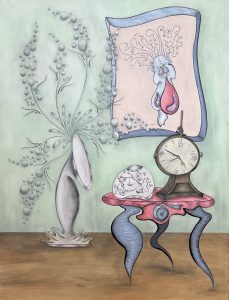Craft your language to be understood
Use your words? Maybe that’s not the best advice for a five or a fifty-year-old.
No one understands you.
I’m sure you expect me to assure you that you are understood and loved and all of that. While that might be true, in many ways, no matter what you say or how you say it, you are not understood — perfectly. And it’s all because of language.
In our daily lives and living, we might not appreciate that words are slippery things. We toss them around, believing others understand exactly what we mean. But effective communication is not that simple.
NOISE
Over breakfast, you ask your partner to pick up dinner. Your partner didn’t hear you over the coffee grinder.
That is an example of one type of noise that interferes with communication. That type — external noise — blocks or cuts off the communication route. Just like in a crowded place, you try to talk to your friend, but the music and chatter are too loud. You can hear. Neither can he. Or you are emailing and the building suffers a blackout. No power, no email.
We also have internal noise. The worst is psychological — biases and mental distortion that stop us from understanding each other. Physiological noise also interferes with understanding. Every try to talk to a person with a fever? Or someone who is inebriated? Yeah, that’s noise.
You can read all about noise here.
In this article, I am focusing on the third type of internal noise: semantic.
Semantic noise happens when the speaker (the sender of the communication) uses words the listener (the receiver of the communication) can’t understand. This includes not speaking the same language. Or the doctor who uses medical terms so you do not know if you are going to live or die. The lawyer, pompous and not self-aware, who speaks in half-Latin. Or even your new boss who peppers every sentence with industry and office jargon.
But semantic noise is not always so obvious.We’re adults here. We understand having to translate or to use less jargon. Those are obvious to any educated adult.
I want to chat about the sneaky semantic predator connotation.
LANGUAGE & MEANING
Language is the system and construction of words used by people, typically from the same geographical region. So when you are visiting Punta Cana, you’d better learn the Spanish word for bathroom. And bottled water. These are things I have learned the hard way.
And you get it. Foreign country, learn a few words. In the United States, we should at least be fluent in English and Spanish. But even if you are a freaking English professor, you will still suffer semantic noise!
See, the meaning of any word does not live in the word itself — but in the receiver of that word. We say meaning is context bound: the meaning of any word is tied to the context — the conversation or event. But the meaning of any word is also tied to the receiver’s (listener’s) experience.
We know that each word has a definition. That’s its denotation. For example, the word tree. Mirriam-Webster defines tree as: a woody perennial plant having a single usually elongate main stem generally with few or no branches on its lower part. But I am absolutely certain that you do not think that definition when I say the word tree.
You probably think of a particular tree. Go ahead. Check your brain.
That’s the word’s connotation. It’s your personal meaning for the word tree.
Let’s try something: If I say the word cat to you, you think of a picture in your mind. Do that now. What does the cat look like? Choose four or five words to describe it and note down what you see in your mind. Actually, do this. Get a pen. Write.
What did you describe?
You are probably wrong. I was not thinking about that description when I said cat.
Try again.
Still wrong. I was thinking of a large, orange tabby with green eyes. That’s what I was saying! Did you not hear me?!?!
Does your mental picture make you, the receiver, ignorant or confused? No, it makes me, the sender, a poor encoder. The word cat means different things to different people. A zoologist may picture a lion; a veterinarian may imagine a Bombay cat. A guy who rescues cats may have thought of a recent rescue. Someone who dislikes cat may have thought of scratches or damaged furniture. A person with allergies may actually wince and only think of swollen eyes!
You tell a friend you are going camping. She winces. “Ugh, not camping!”
“What’s wrong with camping?” you ask. You love camping. You spent summers as a kid camping with your family in the Pocono mountains. Fireside chats and lightning bugs. S’mores and grilled fish. Fishing and boating. Heaven.
She says, “I went camping once. On the beach. It rained the entire time — until the sun finally came out the last day and mosquitoes attacked me.”
While this is an extreme and oversimplified example, the word campingrepels your friend. The meaning lives with the receiver — not with the sender. So if you invite her camping, and do not know her connotation for the word, and she declines the invitation, you wonder if your friendship is at risk, if she is unwell, if she is choosing another activity over spending time with you…
Words are the source of misunderstandings. — Antoine de Saint-Exupery, The Little Prince.
What about that word cat? What if the person does not like cats? That word will have a negative connotation — an emotional impact on the receiver. Just like it will have a positive emotional connotation on a person who loves kitties.
As speakers, we must be aware of how our words will affect our listeners. And although language allows us to communicate complex concepts to others, we must be vigilant in how to communicate that complexity — understanding it is not what we say but how it is received. The only message that counts is the one received — no matter what you intended. Therefore, we must carefully encode what we are to say to another person.
THAT’S A LOT OF WORK
I recall when I first learned about connotation and semantic noise, I felt defeated. Everything I communicate has the potential to be misunderstood! Yes, but in most cases, these everyday conversations resolve semantic noise. You learn your potential roommate is allergic to cats. You learn your friend is not a fan of camping.
Where connotation becomes difficult is where we are in a business negotiation or making a sales pitch. Where we are in a deep conversation with our partner. Or teaching a child. Defeatism cannot be the default: We must be aware that the other person is not decoding what we say exactly how we mean to say it.
When I was a teenager, my aunt called me cute. I was incensed and withdrew to my room for most of the day. Cute? Babies are cute. Kittens are cute. I am a young girl. Cute is for babies. I’m gorgeous, hot, charming. Not cute. For me, cute meant childish.
Yes, I know the denotation of cute is attractive or pretty in a youthful or delicate way. I should have taken the compliment — which I’m sure is how she meant it. But denotation doesn’t matter. Only connotation matters. But how was my aunt to know? She couldn’t. I don’t think she can read minds. She was paying me a compliment, and I went and sulked. Talk about childish!
How can we police our encoding efforts?
In the famous treatise, The Meaning of Meaning: A Study of the Influence of Language upon Thought and of the Science of Symbolism, Ogden and Richards (1927) discuss how we lose meaning when communicating to others. The authors especially discuss how no word has a precise meaning: meaning is too different for each receiver. They also suggest means to reduce misunderstanding, including providing explicit definition or examples for a particular term, or using clear visual examples or metaphor. As speakers, we are seeking precision: To describe clearly the idea in one’s mind to others.
What if my aunt has not mindlessly flung the word cute around? What if she had said: “You are like a little fairy princess! I watch you scamper around, all smiles! You are so lovely. It’s very cute!”
Ah. That’s very different. And would have led to a positive outcome.
Remember that misuse of language can lead to miscommunication, and that miscommunication leads to everything that has ever happened in the whole of the world. — Joseph Fink and Jeffrey Cranor
The sender, the speaker, must consider the dictionary meaning of vital words — the denotation — and the personal meaning of vital words, theconnotation. The sender is attempting to draw a picture in the minds of the audience members — so the sender must narrow the words, carefully choosing each, to mean what he or she wants to mean. Use expressive language, examples, and metaphor.
Powerful speakers define terms when they speak. Powerful speakers use stories and imagery. We want to be clear for every individual in our audience. The key is to resolve any ambiguity. Consider the difference in saying:
- I like movies.
- I like old movies.
- I like old, black and white movies.
- I like classic films.
- I like classic films like Gaslight and Citizen Kane.
The last, least ambiguous statement reduces the possibility of noisy connotation. Movie can mean anything. With descriptive and precise language, the meaning is clear.
HAVE FUN
When my husband tells me to take a lazy day, I freak. To me, lazy is bad and irresponsible. He thinks of lazy as a vacation: to laze, to relax. The dictionary says: (1) disinclined to activity or exertion; (2) encouraging inactivity or indolence. His connotation focuses on inactivity. Mine focuses on indolence. We are both right — but not communicating as best as we could.
Now he tells me to “take it easy.” That I understand as get a cup of tea and a favorite book and cuddle with the cat. The phrase “take it easy” doesn’t trigger my type-A personality.
Define the following terms in your own words. Then check the dictionary for the actual (agreed upon and full) meaning of the word. Compare your responses with a loved one. It will surprise you how your connotations differ. And how your communication will improve!
- love
- lazy
- work
- clean
- truth
- anger
- classy
- fair
- cuisine
- art
- talented
- expensive
- justice



